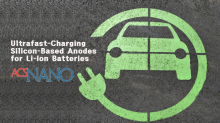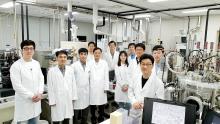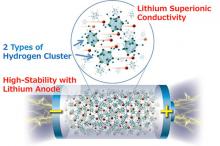Energy
News

26 Sep 2019
SIEW 2019 will run from 29 October to 1 November 2019 at the Sands Expo and Convention Centre, Marina Bay Sands, Singapore. Register your attendance at www.siew.sg before 30 September 2019 to enjoy early bird discounts of up to S$300.
19 Sep 2019
DGIST Division of Energy Technology achieves the highest photoelectric conversion efficiency in the world. Huge expectations toward the commercialization of flexible solar cell that is applicable in various fields.
13 Sep 2019
Singapore International Energy Week, 29 Oct - 1 Nov 2019
12 Sep 2019
Researchers from China, France and the USA have evaluated China’s success in stemming emissions from its coal-fired power plants (CPPs).
31 Aug 2019
Advanced Materials publishes a special issue, highlighting some of the outstanding works of South Korea's Ulsan National Institute of Science and Technology (UNIST).
29 Aug 2019
A summer exchange program, operated by South Korea's Ulsan National Institute of Science and Technology (UNIST) and Harvard John A. Paulson School of Engineering and Applied Sciences (SEAS), ended with great success.
27 Aug 2019
Two outstanding scholars, affiliated with UNIST have distinguished themselves with inclusion in the ‘Next Generation of Energy Scientists,’ selected by S. Korea’s most prominent research organization.
27 Aug 2019
A recent study, affiliated with South Korea's Ulsan National Institute of Science and Technology (UNIST) has reported a highly flexible Metal-Organic Framework (MOF) with the NPR property.
27 Aug 2019
A recent study, affiliated with South Korea's Ulsan National Institute of Science and Technology (UNIST) has unveiled a new way to turn discarded eggshells into hydrogen, an innovative and alternative energy for the future.
27 Aug 2019
A recent study, affiliated with South Korea's Ulsan National Institute of Science and Technology (UNIST) has presented noble catalysts for water electrolysis, capable of generating hydrogen and oxygen at the same time.
27 Aug 2019
A recent study, affiliated with South Korea's Ulsan National Institute of Science and Technology (UNIST) has demonstrated new solvent-free, single lithium-ion conducting COF.
27 Aug 2019
Japanese scientists have found a new way to successfully detect the efficiency of crystal semiconductors. For the first time ever, the team used a specific kind of photoluminescence spectroscopy, a way to detect light, to characterize the semiconductors. The emitted light energy was used as an indicator of the crystal's quality. This method potentially culminates in more efficient light-emitting diodes (LEDs) and solar cells. Additionally, it could usher in several other advances in electronics.
26 Aug 2019
A recent study, affiliated with South Korea's Ulsan National Institute of Science and Technology (UNIST) has challenged themselves with developing tandem solar cells for the first time, thus received much attention for achieving 21.19% efficiency.
26 Aug 2019
An international team of researchers, affiliated with UNIST has paved the way for the development of next-generation batteries, targeting high-performance electric vehicles (EVs).
26 Aug 2019
A recent study, affiliated with South Korea's Ulsan National Institute of Science and Technology (UNIST) and Korea Research Institute of Standards and Science (KRISS), has succeeded in fabricating highly alligned SnSe thin films through a low-cost and scalable solution process.
26 Aug 2019
A recent study, affiliated with South Korea's Ulsan National Institute of Science and Technology (UNIST) has introduced a novel technology, capable of fabricating highly ordered arrays of graphene quantum dot (GQD). This research has gained much attention from academia since it was introduced in the February 2019 issue of Nature Nanotechnology.
13 Aug 2019
Hosted by the nation’s premier power supplier, Tenaga Nasional Berhad (TNB),
Asian Utility Week is being brought together with POWERGEN Asia, DISTRIBUTECH Asia, SolarVision and Energy Capital Leaders Asia under one roof for the first time
31 Jul 2019
Now in its 12th edition, the Singapore International Energy Week (SIEW) is a premier platform in Asia for energy insights, partnerships and dialogues, which brings together the world’s leading conferences, exhibitions and roundtables in one week, one location.
08 Jul 2019
DGIST Professor Yong Min Lee’s team in the Department of Energy Science and Engineering succeeded in developing an electrochemical model that can predict and analyze the electrochemical phenomena of the single particles of electrode active materials. Expects to be used in a single particle design research to improve cell efficiency.
28 May 2019
Researchers at Convergence Research Center for Solar Energy at Daegu Gyeongbuk Institute of Science and Technology (DGIST), South Korea, have achieved the confirmed highest single-junction cell efficiency in the world. Expects to be commercialized by using low cost, ecofriendly materials.
23 May 2019
Researchers at The Hong Kong Polytechnic University (PolyU) have developed a highly flexible, high-energy Textile Lithium Battery.

16 May 2019
DGIST agreed on Energy Research Cooperation with CNR-ITAE in Italy. Held a joint symposium on the latest energy research. Agreed to share research performance and conduct joint research in new and renewable energy materials.

26 Mar 2019
Accelerating Energy Transformation at Singapore International Energy Week 2019
25 Mar 2019
Scientists from Tohoku University and the High Energy Accelerator Research Organization have developed a new complex hydride lithium superionic conductor that could result in all-solid-state batteries with the highest energy density to date.

25 Mar 2019
Stimulate the global phenomenon of rapid development of cities into the future
19 Mar 2019
A novel solar panel tracer is faster, less expensive and more accurate than conventional devices.
06 Mar 2019
The ability of thermoelectric materials to convert heat into electricity has been more than doubled. This could help reduce the amount of wasted heat, and thus wasted fossil fuel, in daily activities and industries.
25 Feb 2019
Deep ultraviolet light-emitting diodes (DUV-LEDs) made from aluminium gallium nitride (AlGaN) efficiently transfer electrical energy to optical energy due to the growth of one of its bottom layers in a step-like fashion. This finding, published in the journal Applied Physics Letters, can lead to the development of even more efficient LEDs.
25 Feb 2019
DGIST Senior Researcher Changsoon Choi’s team coiled the existing carbon nano tube/spandex fiber and developed a new fiber of supercoiled structure. Expects to be applied in developing various wearable device platforms with super-coil that stretches up to 16 times
20 Feb 2019
Scientists are investigating the potential of non-toxic materials to replace lead in perovskite solar cells.
Events
Sorry, no events coming up for this topic.
Researchers
Sorry, no researchers coming up for this topic.
Giants in history
Julian Arca Banzon (13 March 1908 – 13 September 1988) was a biochemist from the Philippines who was a pioneer in alternative fuel research. Banzon investigated the use of indigenous crops as sources of renewable fuels and chemicals.
Anna Mani (23 August 1918 – 16 August 2001) was an Indian meteorologist who contributed significantly to the understanding of solar radiation, ozone and wind energy by developing a wide range of measurement tools. One of India’s pioneering female scientists, Mani excelled in the male-dominated area of meteorology and became the Deputy Director-General of the India Meteorological Department.





























